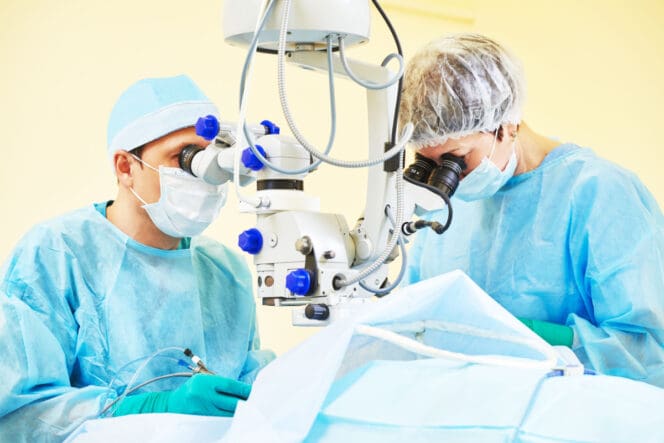Home / Eye Surgery /
YAG Eye Surgery: What It Is, Uses, Outcomes & More
YAG capsulotomies help patients reduce opacification following cataract surgery. This is a fairly common clouding that can occur on the artificial lens inserted during cataract surgery.

Using a laser, surgeons make a small opening, helping to improve your sight within 24 hours. YAG eye surgery is a fairly minor procedure with a quick recovery period.
The Purpose of YAG Eye Surgery
A neodymium:yttrium-aluminum-garnet (Nd:YAG) laser posterior capsulotomy is a type of laser eye surgery that can help counter a loss in visual acuity from opacification of the posterior capsule. This is a common complication after the extraction of senile cataracts, in which scarring causes your vision to become hazy or blurred.
While the terms YAG surgery and Nd:YAG posterior capsulotomy are often used interchangeably, it is notable that other types of surgeries can be performed with YAG lasers. Some procedures accepted as medically necessary in relevant situations by insurance companies such as Aetna include the following:
- Nd:YAG laser peripheral iridotomy
- ND-YAG laser goniotomy
- Venous malformation treatment
Below, YAG eye surgery refers specifically to an Nd:YAG laser posterior capsulotomy.
Who Is a Candidate for YAG Eye Surgery?
A viable candidate for this procedure is someone who experienced opacification and saw a reduction in their vision after cataract surgery. This occurs in about 20 percent of cataract surgery patients.
What to Expect With YAG Eye Surgery
A YAG laser capsulotomy is a relatively easy procedure. Posterior capsule opacification (PCO) cannot recur, so a patient only needs the surgery once.
The procedure usually goes as follows:
- Your eyes are numbed and dilated with two kinds of medicated eye drops.
- A laser is pointed at your lens capsule.
- The laser is used to make a small opening in the capsule, clearing your clouding.
- Your vision should soon clear.
- You may get prescribed antibiotic or anti-inflammatory eye drops for about a week.
- If the surgery is successful, your sight will improve in about 24 hours.
The procedure is short and an outpatient procedure, meaning you can leave the same day you get it, barring any complications.
Recovery
Healing from YAG eye surgery is a straightforward process, but you will need someone to drive you home after surgery.
There is essentially no downtime following this surgery. You may see floaters in your vision, but these should clear in the coming weeks.
Benefits & Risks of YAG Eye Surgery
YAG eye surgery can reduce opacification, making the capsule you see through less cloudy. Any blurriness you experience due to this opacification is thus reduced.
Swelling is common during recovery, requiring the use of anti-inflammatory steroid eye drops.
This surgery may increase pressure in your eye. Abnormal pressure in the eye can lead to glaucoma, which can cause vision problems, including blindness.
In some cases, your IOL, the artificial lens put in place during cataract surgery, can sometimes move through the opening made during YAG eye surgery, causing further complications.
Some associate YAG capsulotomies with retinal detachment (RD), but the evidence of this is mixed. A review article that looked at several studies noted that uncomplicated cataract extractions themselves increase the risk of retinal detachment. It might be that some people are incorrectly assuming RDs are linked to capsulotomies.
YAG Eye Surgery FAQs
How soon can you drive after YAG eye surgery?
You can usually drive 24 hours after YAG eye surgery.
Will I see clearly after YAG eye surgery?
You may see more floaters immediately following surgery, but these will clear within a couple weeks.
References
-
Does Nd:YAG Capsulotomy Increase the Risk of Retinal Detachment? (September 2018). Asia-Pacific Journal of Ophthalmology.
-
Nd:YAG Laser Posterior Capsulotomy. (November 2013). American Academy of Ophthalmology.
-
Safety and Efficacy of YAG Laser Vitreolysis for the Treatment of Vitreous Floaters: An Overview. (February 2020). Advances in Therapy.
-
Posterior Capsule Opacification. University of Michigan Health System.
-
What Is a Posterior Capsulotomy? (November 2021). American Academy of Ophthalmology.
-
YAG Laser in Ophthalmology and Other Selected Indications. (May 2021). Aetna.
-
Posterior Capsule Opacification: A Review of Experimental Studies. (June 2021). Medical University of Bialystok.
-
5-Year Incidence of YAG Capsulotomy and PCO After Cataract Surgery With Single-Piece Monofocal Intraocular Lenses: A Real-World Evidence Study of 20,763 Eyes. (October 2019). Eye.
Last Updated May 23, 2022
Note: This page should not serve as a substitute for professional medical advice from a doctor or specialist. Please review our about page for more information.